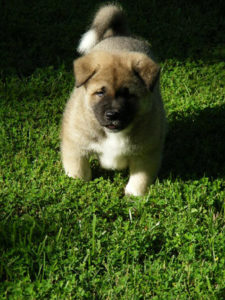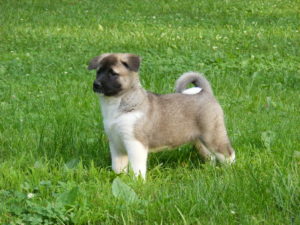Feeding Your Puppy
At RH Akitas we use a goat milk base veterinary approved formula to supplement our 1-3 week old pups’ feedings. We then wean the pups with this formula and canned Nutro-max for puppies to make a cereal. The pups LOVE this stuff! We then move on to canned puppy food only, all the while providing them a consistent access to clean water. Next, we move on to a canned and dry puppy kibble moistened with a bit of water. We use less of the canned as we move on into the weaning process. Our customers always get a supply of the dry kibble and canned food in their Puppy Care Kits to they can continue on weaning their pup to the food of their choice.

Proper nutrition for your new dog is key to helping him live a long, healthy life.
Selecting a Puppy Food
Dogs are as individual as people. Large, small, young or old, despite their differences, they all need a well-balanced diet for good health. Yet dogs of different ages and sizes have different nutritional needs. This is especially significant when it comes to puppies.

The energy requirements of a puppy can be nearly twice that of an adult dog, and a puppy may not have the stomach capacity to eat enough food to meet his needs unless the food is specifically formulated to do so. Follow these guidelines when choosing a food:
Provide a highly digestible, nutrient- dense, 100% complete and balanced premium formula for growth. High-quality formulas contain such vitamins, minerals, protein, fat and carbohydrates your dog needs for sound and healthy development.
Feed a formula based on breed size. Puppies experience their most rapid period of growth during the first six months of life, and because growth rates differ among breed sizes, you need to feed a formula designed to address the needs of your puppy’s breed and or size.
Feed puppies based on the recommended amounts for weight and age and feed this formula until your puppy is an adult. Some pups are slow to wean – adding high quality canned food will encourage them to eat more.

Large-breed puppy nutrition
Although large-breed dogs have bigger bones than medium or small breeds, large-breed puppies do not need more calcium. Studies have shown that:
- Rapidly growing, large-breed pups are more inclined to exhibit developmental bone problems.
- Controlling the rate of growth is more beneficial than promoting rapid growth.
- Moderating calcium, phosphorus and calorie levels in their diet promotes normal skeletal development.
Overfeeding and weight gain can actually contribute to developmental bone problems. This makes managing food intake very important. Research has shown that puppies are at increased risk for developmental bone problems if they are overfed.

Dry, canned and biscuits
Once you’ve decided on a premium formula, you have another choice to make: dry or canned. And what about biscuits?
- Premium dry dog food gives you the best value and convenience while providing your dog with high-quality nutrition. Premium dry foods come in a number of bag sizes and formulas suited to size, life stage and activity level. Dry food also helps keep teeth clean and remains fresh for long periods if stored properly.
- Puppy and adult biscuits make great treats and rewards and can add taste variety to your new dog’s diet.
Value of Premium Food +
Low-cost food may be less expensive, but it isn’t always a bargain and may not provide optimum nutrition. Premium food makes sense both nutritionally (because of consistent, high-quality ingredients) and economically because it provides:
- 100% complete, balanced nutrition
- High nutrient and energy density, which translates into smaller feeding portions
- A stable ingredient profile.

High nutrient and energy density
The investment in a super premium food may initially cost more per bag, but because these high-quality formulas are high in nutrient density, your dog may need less food, which can offset the higher cost per unit of weight. On a cost-per-feeding basis, look at how much you feed each day as opposed to how much the bag costs, because nutrient and energy density will generally be lower for a low-cost food compared with premium foods.
- Foods from reputable dog food companies such as IAMS, SCIENCE DIET, NUTRO, Taste of the Wild, Diamond Natural, etc are fixed-formula foods as opposed to least-cost formulas. Fixed formulas have a “stable ingredient profile.” That means the recipes formulated to be 100% complete and balanced do not change with the cost of ingredients.
- With least-cost formulations, the emphasis is on production and ingredient costs. Two bags of the same least-cost formulated food can have different ingredients and/or levels of ingredients. Plus, those ingredients may vary significantly in digestibility—this means simply that you may need to feed more just to equal the nutrition offered by a smaller amount of a premium dog food formula.
Nutrition, Skin, Coat
Feeding studies have shown that a dog’s nutritional requirements are best met by high-quality animal proteins such as those contained in chicken, fish, lamb and eggs. Our formulas are made with these highly digestible proteins, which promote excellent skin and coat condition and enhance your dog’s overall health and well-being. When your dog’s coat looks good, the rest of the body is likely to be well nourished, too.
The role of fatty acids
Fat also plays a key role in keeping your dog’s skin and coat in top condition. Fat not only provides energy, it’s a source of essential fatty acids that are necessary for the skin’s healthy structure. Fatty acids in the diet keep the skin moist and supple. Fatty acids also contribute to a thick, lustrous and healthy coat.
 Important types of fatty acids
Important types of fatty acids
Lack of fat and fatty acids, or the wrong balance of fatty acids, can result in dry, scaly skin and hair/coat problems. A proper balance of fatty acids is key to a healthy coat. Although there are many kinds of fatty acids, a few are important to coat health and appearance:
- Linoleic acid is an essential omega-6 fatty acid for dogs and is necessary for healthy skin. It is found in beef, pork, chicken and some vegetable oils.
- Omega-6 fatty acids, including linoleic acid, can be found in the fat or oils provided in ingredients such as chicken and corn in your dog’s food.
- Omega-3 fatty acids are found in cold-water fish oils and in flax. Although not essential to a dog’s diet, they have been found to help nutritionally manage skin and coat conditions and promote a shiny coat.
A proper fatty-acid balance
An appropriate balance of omega-6 and omega-3 fatty acids helps maintain your dog’s healthy skin and coat. An optimal range of omega-6 to omega-3 fatty-acid ratios is between 5:1 and 10:1, to enhance skin and coat quality and help nutritionally manage skin and coat conditions.
Feeding Instructions
Your new dog’s first meals at home are very important. Find out what formula your dog has been eating and continue feeding this food for a day or two after you bring him home. If you want to change his diet to a premium food, gradually move him from the old food to the new formula and help avoid intestinal upsets by using the following steps:
Day 1: Fill your dog’s bowl with 75 percent of his old food and 25 percent of the new premium formula..
Day 2: Mix the old food and the new premium formula in a 50/50 ratio.
Day 3: Feed your dog a mixture that’s 75 percent new premium formula and 25 percent old food.
Day 4: Feed 100% of the new premium formula.
Feeding Tips
Use the following guidelines to feed your new dog properly:
- To feed a puppy from weaning to four months of age, offer a 100% complete and balanced premium puppy formula. To determine each serving size, start with the daily amount recommended by the feeding guidelines on the pet food label and divide that number by the number of times a day (usually 3 times) you plan to feed your puppy.
- Serve the food at room temperature and remove the bowl within 30 minutes after he’s done eating.
- After four months, you can feed a puppy twice daily on a regular schedule.
- Always provide your dog with clean, fresh water.
- Discard uneaten wet food at the end of the day.
Feeding Tips for a Teething Puppy
Puppies grow quickly and have special nutritional needs. The most noticeable period is known as the rapid growth stage, which occurs between two and six months of age. From about three to six months, most pups will lose their puppy teeth (don’t be alarmed if you occasionally find a tooth near his dish or on the floor).
During this phase, however, a puppy’s mouth and gums may be very sensitive, which could cause him to be a bit picky when it comes to eating. There’s nothing you can do except to wait out this period, even if his appetite is affected for a couple of days.
Helpful hints
Don’t switch to a new formula to stimulate your puppy’s appetite. Changing food at this time can cause additional stress and intestinal upset. To help your puppy make the change, consider the following options:
- Mix his regular premium dry food with a premium canned puppy food to make his diet more appealing.
- Soak dry food in warm water for 10 to 15 minutes before serving.
- Feeding a dry food and biscuits help loosen the teeth so pups can get through the teething process quicker.
If his appetite loss persists, see your veterinarian before you switch food

+Info provided in part from Purina Inc.
